Australian Social Policy: Disability Support Pension Evaluation Report
VerifiedAdded on 2022/10/17
|6
|1313
|121
Report
AI Summary
This report provides an evaluation of the Australian social policy concerning the Disability Support Pension (DSP). It begins with an introduction to social policy and its significance in addressing human needs like education, well-being, and income security. The report then focuses on the DSP, a financial benefit provided by the Australian government to support individuals with physical, intellectual, or psychiatric disabilities. It explores the history and trends of the policy, including the assessment criteria, payment rates, and expenditure growth over time, particularly in relation to the global financial crisis. The report discusses wealth distribution and the government's role in redistributing wealth to reduce poverty, drawing comparisons with other countries and examining citizen responses to the policy, including its impact on work incentives. The analysis highlights the need to understand the factors influencing DSP expenditure growth and evaluates the policy's significance and justification within the Australian context. References from various sources are included to support the analysis.
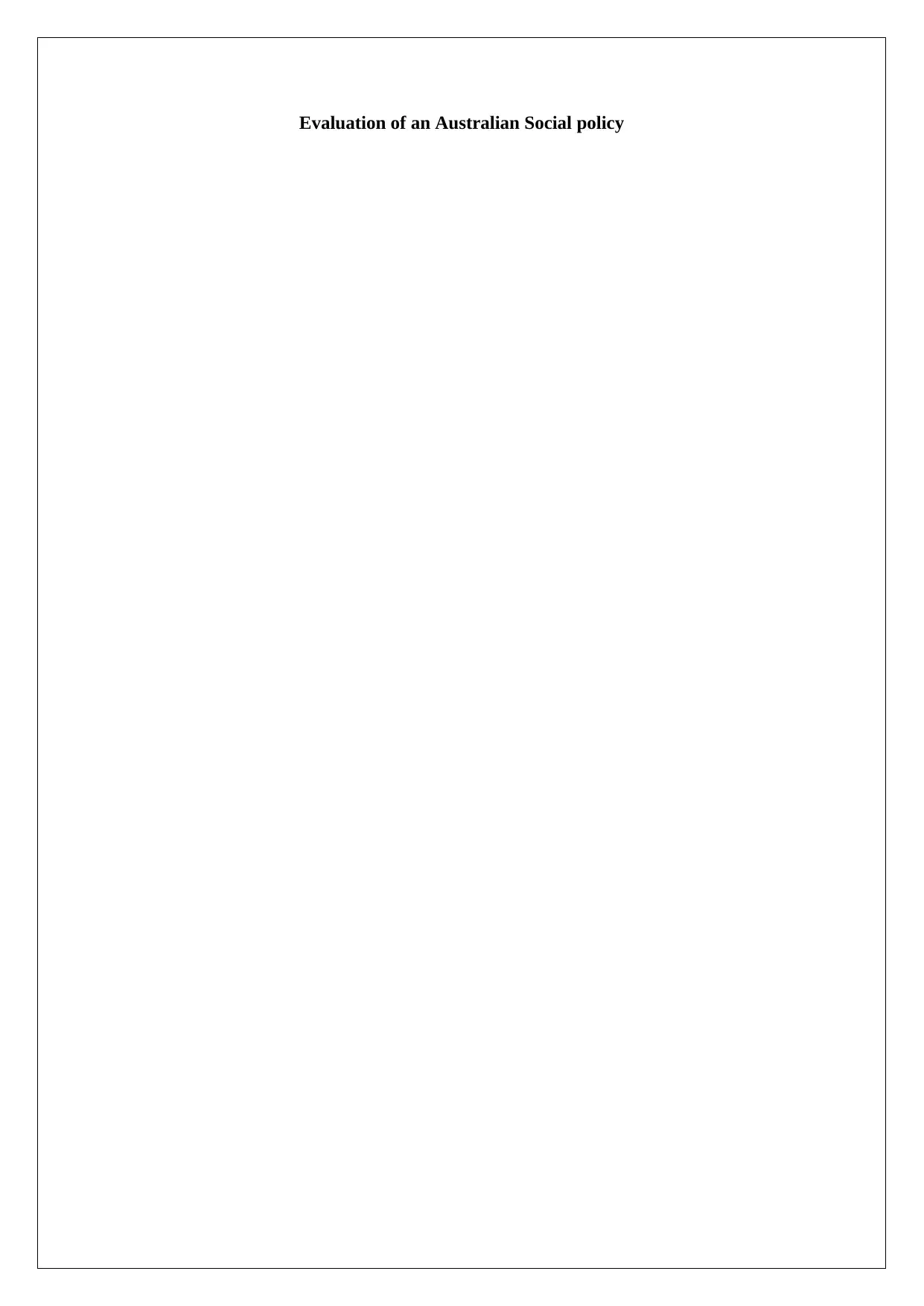
Evaluation of an Australian Social policy
Paraphrase This Document
Need a fresh take? Get an instant paraphrase of this document with our AI Paraphraser
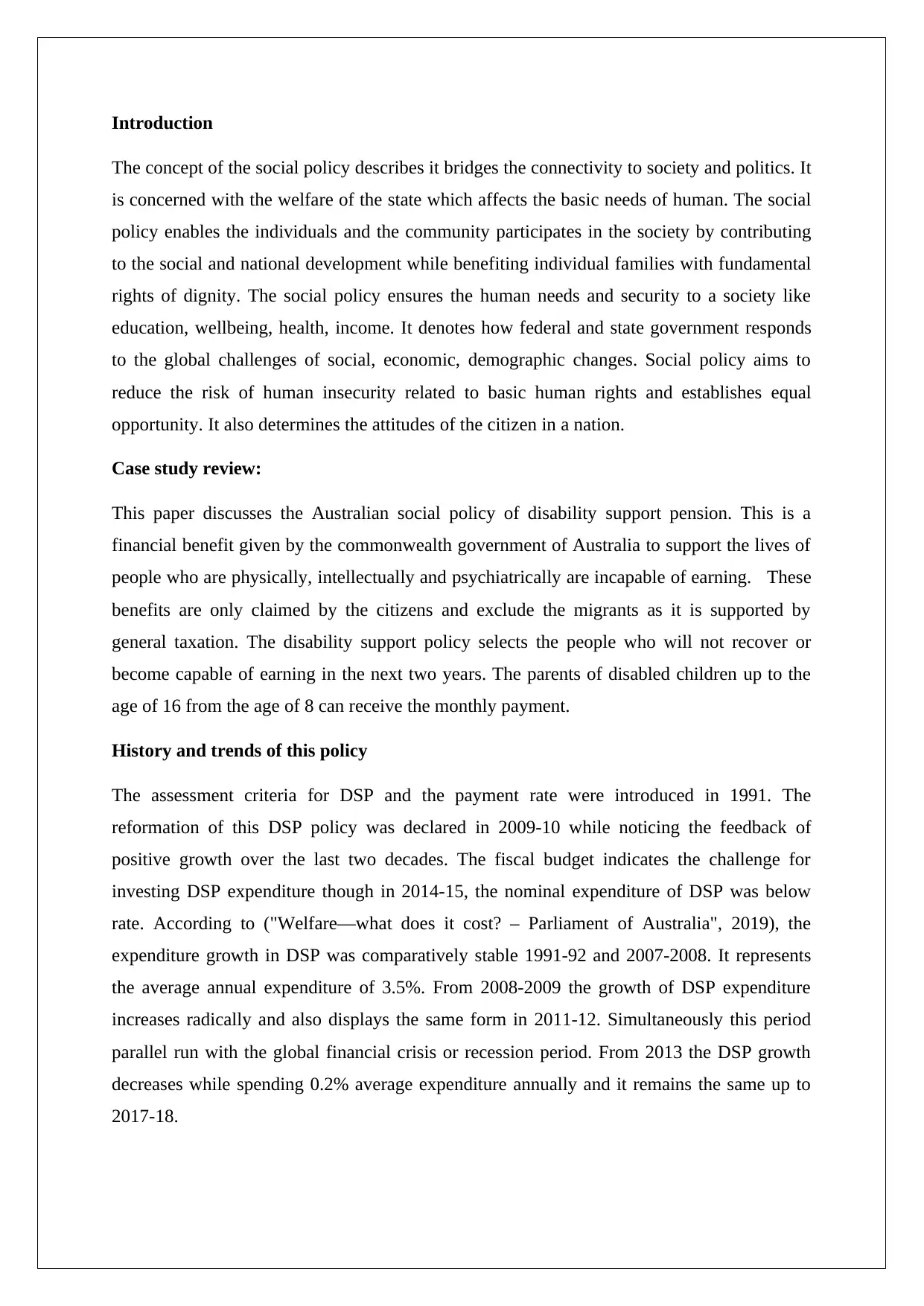
Introduction
The concept of the social policy describes it bridges the connectivity to society and politics. It
is concerned with the welfare of the state which affects the basic needs of human. The social
policy enables the individuals and the community participates in the society by contributing
to the social and national development while benefiting individual families with fundamental
rights of dignity. The social policy ensures the human needs and security to a society like
education, wellbeing, health, income. It denotes how federal and state government responds
to the global challenges of social, economic, demographic changes. Social policy aims to
reduce the risk of human insecurity related to basic human rights and establishes equal
opportunity. It also determines the attitudes of the citizen in a nation.
Case study review:
This paper discusses the Australian social policy of disability support pension. This is a
financial benefit given by the commonwealth government of Australia to support the lives of
people who are physically, intellectually and psychiatrically are incapable of earning. These
benefits are only claimed by the citizens and exclude the migrants as it is supported by
general taxation. The disability support policy selects the people who will not recover or
become capable of earning in the next two years. The parents of disabled children up to the
age of 16 from the age of 8 can receive the monthly payment.
History and trends of this policy
The assessment criteria for DSP and the payment rate were introduced in 1991. The
reformation of this DSP policy was declared in 2009-10 while noticing the feedback of
positive growth over the last two decades. The fiscal budget indicates the challenge for
investing DSP expenditure though in 2014-15, the nominal expenditure of DSP was below
rate. According to ("Welfare—what does it cost? – Parliament of Australia", 2019), the
expenditure growth in DSP was comparatively stable 1991-92 and 2007-2008. It represents
the average annual expenditure of 3.5%. From 2008-2009 the growth of DSP expenditure
increases radically and also displays the same form in 2011-12. Simultaneously this period
parallel run with the global financial crisis or recession period. From 2013 the DSP growth
decreases while spending 0.2% average expenditure annually and it remains the same up to
2017-18.
The concept of the social policy describes it bridges the connectivity to society and politics. It
is concerned with the welfare of the state which affects the basic needs of human. The social
policy enables the individuals and the community participates in the society by contributing
to the social and national development while benefiting individual families with fundamental
rights of dignity. The social policy ensures the human needs and security to a society like
education, wellbeing, health, income. It denotes how federal and state government responds
to the global challenges of social, economic, demographic changes. Social policy aims to
reduce the risk of human insecurity related to basic human rights and establishes equal
opportunity. It also determines the attitudes of the citizen in a nation.
Case study review:
This paper discusses the Australian social policy of disability support pension. This is a
financial benefit given by the commonwealth government of Australia to support the lives of
people who are physically, intellectually and psychiatrically are incapable of earning. These
benefits are only claimed by the citizens and exclude the migrants as it is supported by
general taxation. The disability support policy selects the people who will not recover or
become capable of earning in the next two years. The parents of disabled children up to the
age of 16 from the age of 8 can receive the monthly payment.
History and trends of this policy
The assessment criteria for DSP and the payment rate were introduced in 1991. The
reformation of this DSP policy was declared in 2009-10 while noticing the feedback of
positive growth over the last two decades. The fiscal budget indicates the challenge for
investing DSP expenditure though in 2014-15, the nominal expenditure of DSP was below
rate. According to ("Welfare—what does it cost? – Parliament of Australia", 2019), the
expenditure growth in DSP was comparatively stable 1991-92 and 2007-2008. It represents
the average annual expenditure of 3.5%. From 2008-2009 the growth of DSP expenditure
increases radically and also displays the same form in 2011-12. Simultaneously this period
parallel run with the global financial crisis or recession period. From 2013 the DSP growth
decreases while spending 0.2% average expenditure annually and it remains the same up to
2017-18.
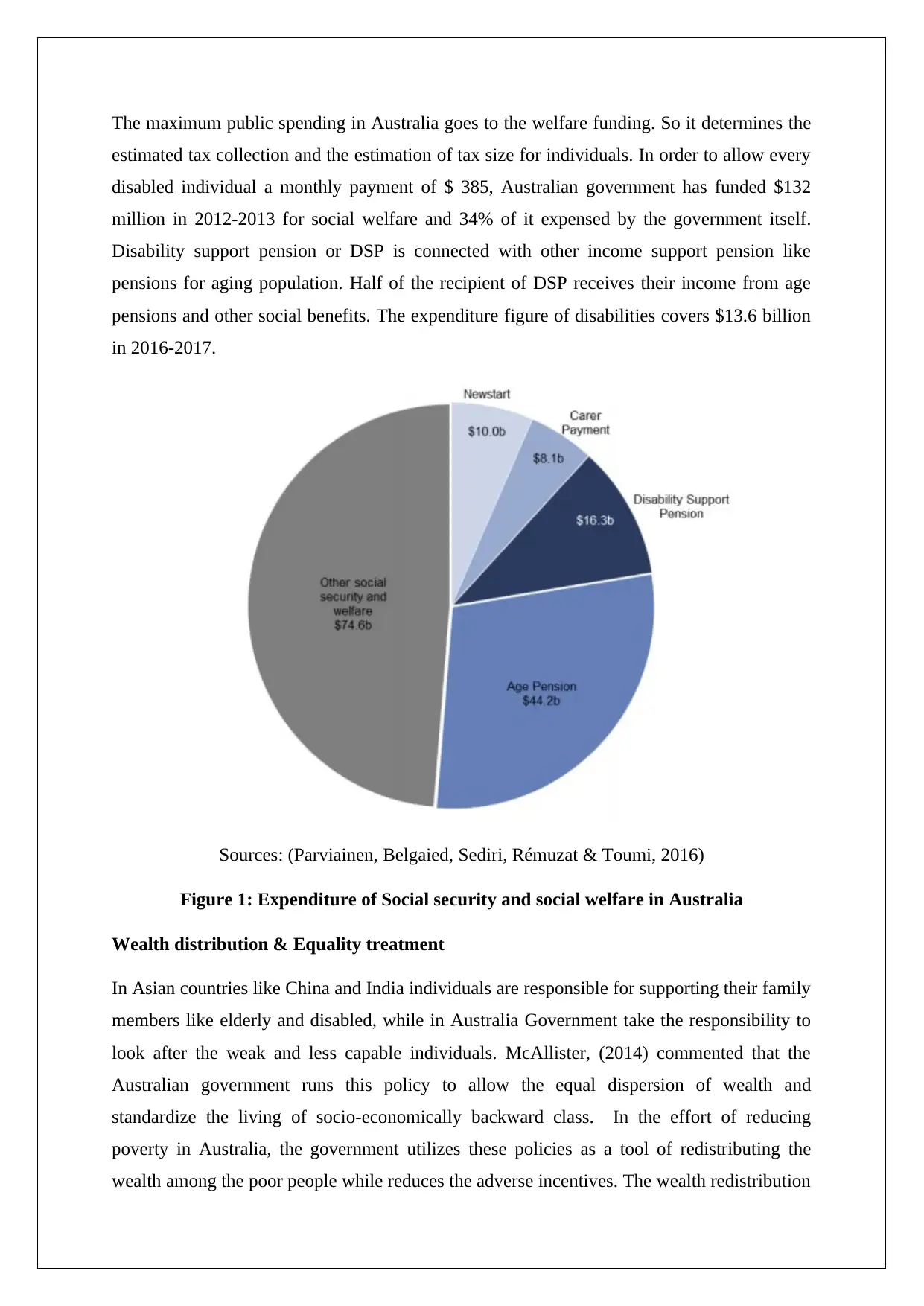
The maximum public spending in Australia goes to the welfare funding. So it determines the
estimated tax collection and the estimation of tax size for individuals. In order to allow every
disabled individual a monthly payment of $ 385, Australian government has funded $132
million in 2012-2013 for social welfare and 34% of it expensed by the government itself.
Disability support pension or DSP is connected with other income support pension like
pensions for aging population. Half of the recipient of DSP receives their income from age
pensions and other social benefits. The expenditure figure of disabilities covers $13.6 billion
in 2016-2017.
Sources: (Parviainen, Belgaied, Sediri, Rémuzat & Toumi, 2016)
Figure 1: Expenditure of Social security and social welfare in Australia
Wealth distribution & Equality treatment
In Asian countries like China and India individuals are responsible for supporting their family
members like elderly and disabled, while in Australia Government take the responsibility to
look after the weak and less capable individuals. McAllister, (2014) commented that the
Australian government runs this policy to allow the equal dispersion of wealth and
standardize the living of socio-economically backward class. In the effort of reducing
poverty in Australia, the government utilizes these policies as a tool of redistributing the
wealth among the poor people while reduces the adverse incentives. The wealth redistribution
estimated tax collection and the estimation of tax size for individuals. In order to allow every
disabled individual a monthly payment of $ 385, Australian government has funded $132
million in 2012-2013 for social welfare and 34% of it expensed by the government itself.
Disability support pension or DSP is connected with other income support pension like
pensions for aging population. Half of the recipient of DSP receives their income from age
pensions and other social benefits. The expenditure figure of disabilities covers $13.6 billion
in 2016-2017.
Sources: (Parviainen, Belgaied, Sediri, Rémuzat & Toumi, 2016)
Figure 1: Expenditure of Social security and social welfare in Australia
Wealth distribution & Equality treatment
In Asian countries like China and India individuals are responsible for supporting their family
members like elderly and disabled, while in Australia Government take the responsibility to
look after the weak and less capable individuals. McAllister, (2014) commented that the
Australian government runs this policy to allow the equal dispersion of wealth and
standardize the living of socio-economically backward class. In the effort of reducing
poverty in Australia, the government utilizes these policies as a tool of redistributing the
wealth among the poor people while reduces the adverse incentives. The wealth redistribution
⊘ This is a preview!⊘
Do you want full access?
Subscribe today to unlock all pages.

Trusted by 1+ million students worldwide
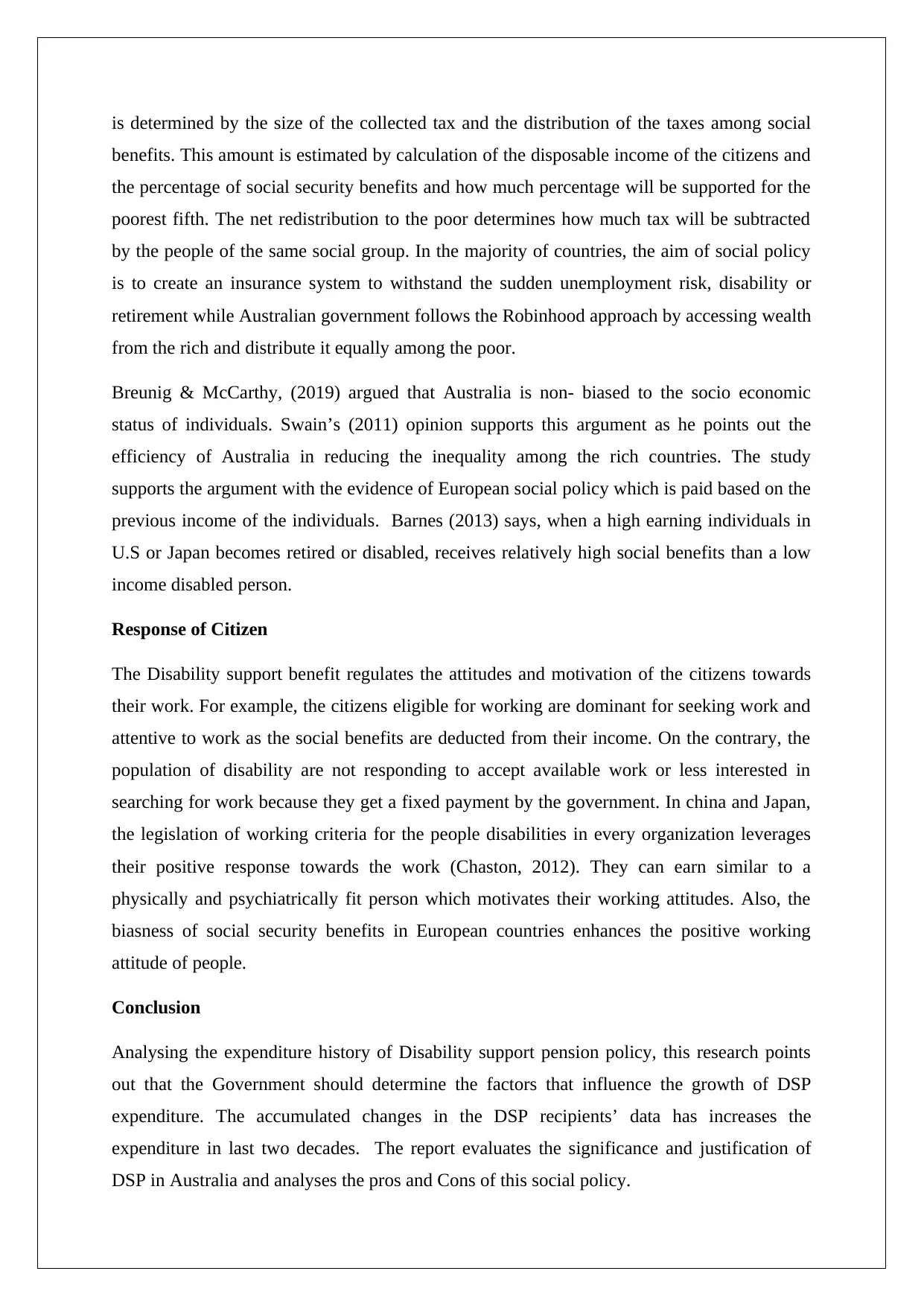
is determined by the size of the collected tax and the distribution of the taxes among social
benefits. This amount is estimated by calculation of the disposable income of the citizens and
the percentage of social security benefits and how much percentage will be supported for the
poorest fifth. The net redistribution to the poor determines how much tax will be subtracted
by the people of the same social group. In the majority of countries, the aim of social policy
is to create an insurance system to withstand the sudden unemployment risk, disability or
retirement while Australian government follows the Robinhood approach by accessing wealth
from the rich and distribute it equally among the poor.
Breunig & McCarthy, (2019) argued that Australia is non- biased to the socio economic
status of individuals. Swain’s (2011) opinion supports this argument as he points out the
efficiency of Australia in reducing the inequality among the rich countries. The study
supports the argument with the evidence of European social policy which is paid based on the
previous income of the individuals. Barnes (2013) says, when a high earning individuals in
U.S or Japan becomes retired or disabled, receives relatively high social benefits than a low
income disabled person.
Response of Citizen
The Disability support benefit regulates the attitudes and motivation of the citizens towards
their work. For example, the citizens eligible for working are dominant for seeking work and
attentive to work as the social benefits are deducted from their income. On the contrary, the
population of disability are not responding to accept available work or less interested in
searching for work because they get a fixed payment by the government. In china and Japan,
the legislation of working criteria for the people disabilities in every organization leverages
their positive response towards the work (Chaston, 2012). They can earn similar to a
physically and psychiatrically fit person which motivates their working attitudes. Also, the
biasness of social security benefits in European countries enhances the positive working
attitude of people.
Conclusion
Analysing the expenditure history of Disability support pension policy, this research points
out that the Government should determine the factors that influence the growth of DSP
expenditure. The accumulated changes in the DSP recipients’ data has increases the
expenditure in last two decades. The report evaluates the significance and justification of
DSP in Australia and analyses the pros and Cons of this social policy.
benefits. This amount is estimated by calculation of the disposable income of the citizens and
the percentage of social security benefits and how much percentage will be supported for the
poorest fifth. The net redistribution to the poor determines how much tax will be subtracted
by the people of the same social group. In the majority of countries, the aim of social policy
is to create an insurance system to withstand the sudden unemployment risk, disability or
retirement while Australian government follows the Robinhood approach by accessing wealth
from the rich and distribute it equally among the poor.
Breunig & McCarthy, (2019) argued that Australia is non- biased to the socio economic
status of individuals. Swain’s (2011) opinion supports this argument as he points out the
efficiency of Australia in reducing the inequality among the rich countries. The study
supports the argument with the evidence of European social policy which is paid based on the
previous income of the individuals. Barnes (2013) says, when a high earning individuals in
U.S or Japan becomes retired or disabled, receives relatively high social benefits than a low
income disabled person.
Response of Citizen
The Disability support benefit regulates the attitudes and motivation of the citizens towards
their work. For example, the citizens eligible for working are dominant for seeking work and
attentive to work as the social benefits are deducted from their income. On the contrary, the
population of disability are not responding to accept available work or less interested in
searching for work because they get a fixed payment by the government. In china and Japan,
the legislation of working criteria for the people disabilities in every organization leverages
their positive response towards the work (Chaston, 2012). They can earn similar to a
physically and psychiatrically fit person which motivates their working attitudes. Also, the
biasness of social security benefits in European countries enhances the positive working
attitude of people.
Conclusion
Analysing the expenditure history of Disability support pension policy, this research points
out that the Government should determine the factors that influence the growth of DSP
expenditure. The accumulated changes in the DSP recipients’ data has increases the
expenditure in last two decades. The report evaluates the significance and justification of
DSP in Australia and analyses the pros and Cons of this social policy.
Paraphrase This Document
Need a fresh take? Get an instant paraphrase of this document with our AI Paraphraser

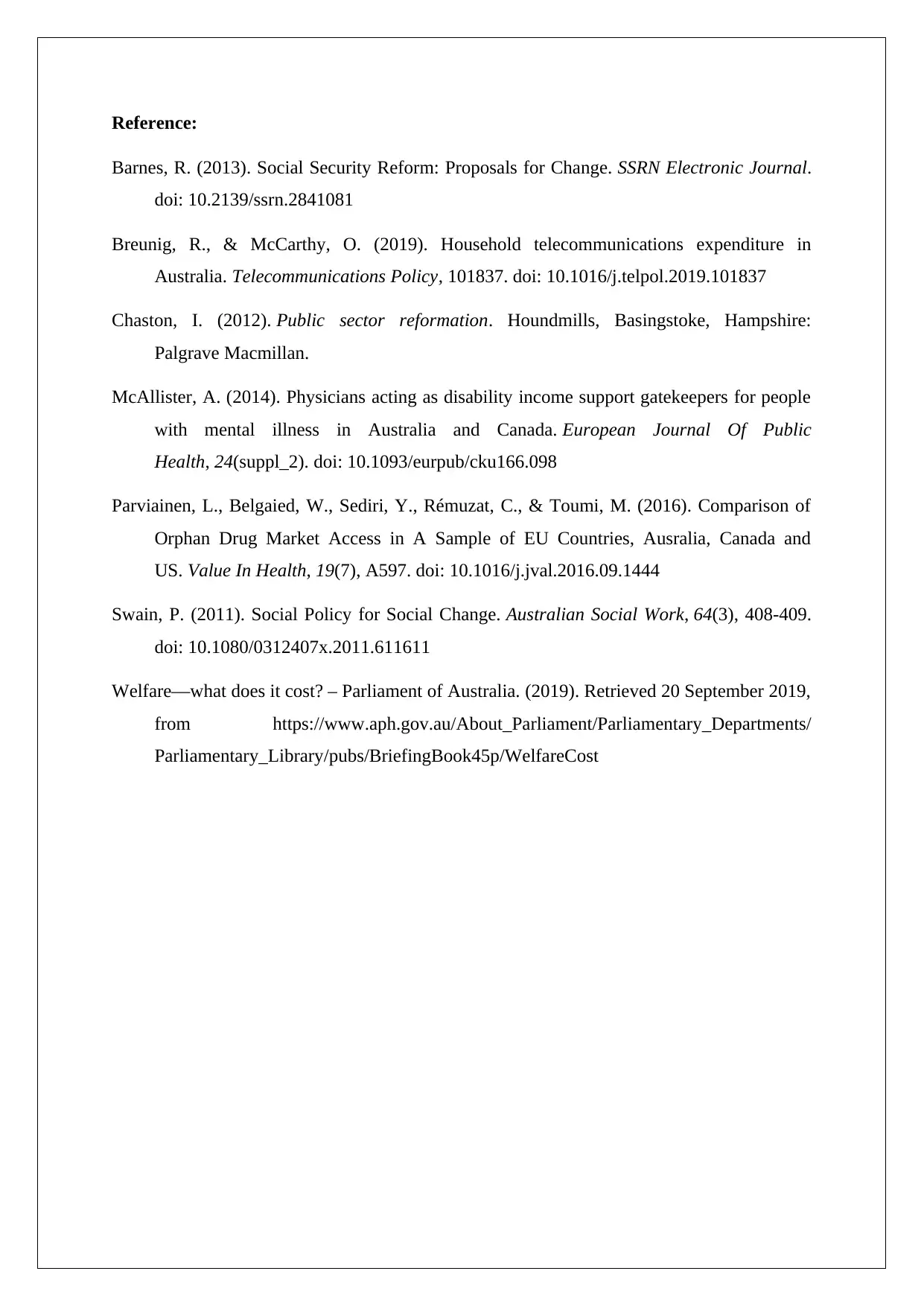
Reference:
Barnes, R. (2013). Social Security Reform: Proposals for Change. SSRN Electronic Journal.
doi: 10.2139/ssrn.2841081
Breunig, R., & McCarthy, O. (2019). Household telecommunications expenditure in
Australia. Telecommunications Policy, 101837. doi: 10.1016/j.telpol.2019.101837
Chaston, I. (2012). Public sector reformation. Houndmills, Basingstoke, Hampshire:
Palgrave Macmillan.
McAllister, A. (2014). Physicians acting as disability income support gatekeepers for people
with mental illness in Australia and Canada. European Journal Of Public
Health, 24(suppl_2). doi: 10.1093/eurpub/cku166.098
Parviainen, L., Belgaied, W., Sediri, Y., Rémuzat, C., & Toumi, M. (2016). Comparison of
Orphan Drug Market Access in A Sample of EU Countries, Ausralia, Canada and
US. Value In Health, 19(7), A597. doi: 10.1016/j.jval.2016.09.1444
Swain, P. (2011). Social Policy for Social Change. Australian Social Work, 64(3), 408-409.
doi: 10.1080/0312407x.2011.611611
Welfare—what does it cost? – Parliament of Australia. (2019). Retrieved 20 September 2019,
from https://www.aph.gov.au/About_Parliament/Parliamentary_Departments/
Parliamentary_Library/pubs/BriefingBook45p/WelfareCost
Barnes, R. (2013). Social Security Reform: Proposals for Change. SSRN Electronic Journal.
doi: 10.2139/ssrn.2841081
Breunig, R., & McCarthy, O. (2019). Household telecommunications expenditure in
Australia. Telecommunications Policy, 101837. doi: 10.1016/j.telpol.2019.101837
Chaston, I. (2012). Public sector reformation. Houndmills, Basingstoke, Hampshire:
Palgrave Macmillan.
McAllister, A. (2014). Physicians acting as disability income support gatekeepers for people
with mental illness in Australia and Canada. European Journal Of Public
Health, 24(suppl_2). doi: 10.1093/eurpub/cku166.098
Parviainen, L., Belgaied, W., Sediri, Y., Rémuzat, C., & Toumi, M. (2016). Comparison of
Orphan Drug Market Access in A Sample of EU Countries, Ausralia, Canada and
US. Value In Health, 19(7), A597. doi: 10.1016/j.jval.2016.09.1444
Swain, P. (2011). Social Policy for Social Change. Australian Social Work, 64(3), 408-409.
doi: 10.1080/0312407x.2011.611611
Welfare—what does it cost? – Parliament of Australia. (2019). Retrieved 20 September 2019,
from https://www.aph.gov.au/About_Parliament/Parliamentary_Departments/
Parliamentary_Library/pubs/BriefingBook45p/WelfareCost
⊘ This is a preview!⊘
Do you want full access?
Subscribe today to unlock all pages.

Trusted by 1+ million students worldwide
1 out of 6
Related Documents
Your All-in-One AI-Powered Toolkit for Academic Success.
+13062052269
info@desklib.com
Available 24*7 on WhatsApp / Email
![[object Object]](/_next/static/media/star-bottom.7253800d.svg)
Unlock your academic potential
Copyright © 2020–2025 A2Z Services. All Rights Reserved. Developed and managed by ZUCOL.




